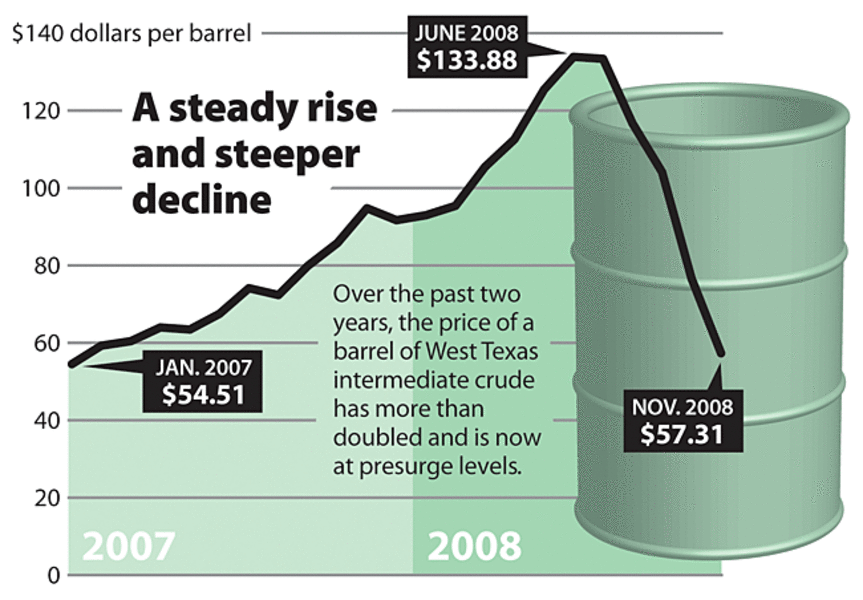Oil industry adjusts to lower prices
Loading...
| Houston
Oil's swan dive from a record high of $147 a barrel last summer to a trading price of $46.10 Thursday, the lowest level in nearly four years, has rattled America's energy industry. But it hasn't flattened it – so far.
What the price drop does mean is that some oil-patch wildcatters have packed up their drill bits as the rush for new domestic exploration has cooled since summer.
"Six months ago everything was roses, and nobody in this business had any inkling that oil prices would decline virtually $100 a barrel," says Alex Mills, president of the Texas Alliance of Energy Producers. Now, he says, "some people have already pulled back on their drilling programs."
No doubt, profits for Big Oil will tumble from this year's record highs. And because of the tightening credit market, many producers – majors and independents – will shut down drilling rigs and trim production in the year ahead.
Fifty-seven percent of the chief financial officers at US oil and gas companies said it's "credit capacity restraints" that will be their most significant challenge in 2009, according to a survey released Tuesday by the accounting firm BDO Seidman.
The oil executives' No. 2 concern is falling prices. While some oil traders are speculating that crude could sink to $30 a barrel in the first quarter of 2009, the outlook from the Energy Information Administration (EIA) has average prices for next year at $63.50.
Sixty-dollar-a-barrel oil is a strong price for the industry, say energy experts and insiders – still higher than 2005 prices.
"The oil industry never imagined that prices would go to $147," says Amy Myers Jaffe, an energy expert at Rice University in Houston. "Obviously, some things have changed if you are a consumer and you are going to the pump, but really, from the industry's point of view, nothing has changed."
For the majors – who have very deep pockets and long-term outlooks – this might be the case. Chevron, which posted $7.89 billion in earnings in the third quarter this year, says its capital program – money intended for finding and developing new sources of energy – will probably remain at a 2008 level of $22.9 billion next year.
"We have experienced a number of years of strong earnings and cash flow that have enabled us to invest in high-quality projects that are either now on line or will start up in the coming year," said Chevron spokesman Kurt Glaubitz in an e-mail response to questions.
Chevron, Exxon Mobil, BP, Royal Dutch Shell, and ConocoPhillips collectively earned $44.4 billion from July 1 to Sept. 30, a 58 percent jump over that period a year earlier, according to the Associated Press, mainly because of the steady climb in prices that peaked at $147 per barrel on July 11.
The rapid fall since then is largely due to grim economic forecasts and the slowdown in overall global demand. While the Organization of Petroleum Exporting Countries (OPEC) is expected to lower production levels at a meeting in Algeria on Dec. 17, the EIA says that oil prices will "primarily depend on the magnitude and duration of the economic downturn as well as OPEC and non-OPEC behavior."
The industry has certainly endured down cycles before and will again, says Sara Banaszak, an economist with the American Petroleum Institute, an industry group. But producers and drillers will back off more expensive, or marginal, operations, she says.
"When demand is high, more marginal resources will go into production." Now, Ms. Banaszak says, "higher-price areas will come out of production.... The marginal fields are the ones that respond to changes in price and demand."
Bruce Vincent, president of the Houston-based independent oil and gas company Swift Energy, takes a somewhat Darwinian view of the price plunge. It gets rid of many of the upstarts who were trying to cash in on rising prices, he says.
To be successful in this business, says Mr. Vincent, requires patience and prudence. But it also requires adjusting to markets. Swift, which is one of the top 50 energy companies in the United States, will have to reduce capital budgets and release some rigs, he says.
Drilling rig counts are already down across Texas, the largest US petroleum producer. Rigs, used to explore for oil and gas, dropped from 925 on Oct. 17 to 899 as of Nov. 14, according to Mr. Mills of the Texas Alliance of Energy Producers.
"Some drilling companies have laid down some of their rigs. Whether they'll let those crews go or not remains to be seen," Mills says.
But industry experts and insiders alike don't foresee large-scale layoffs, such as those during previous slumps.





